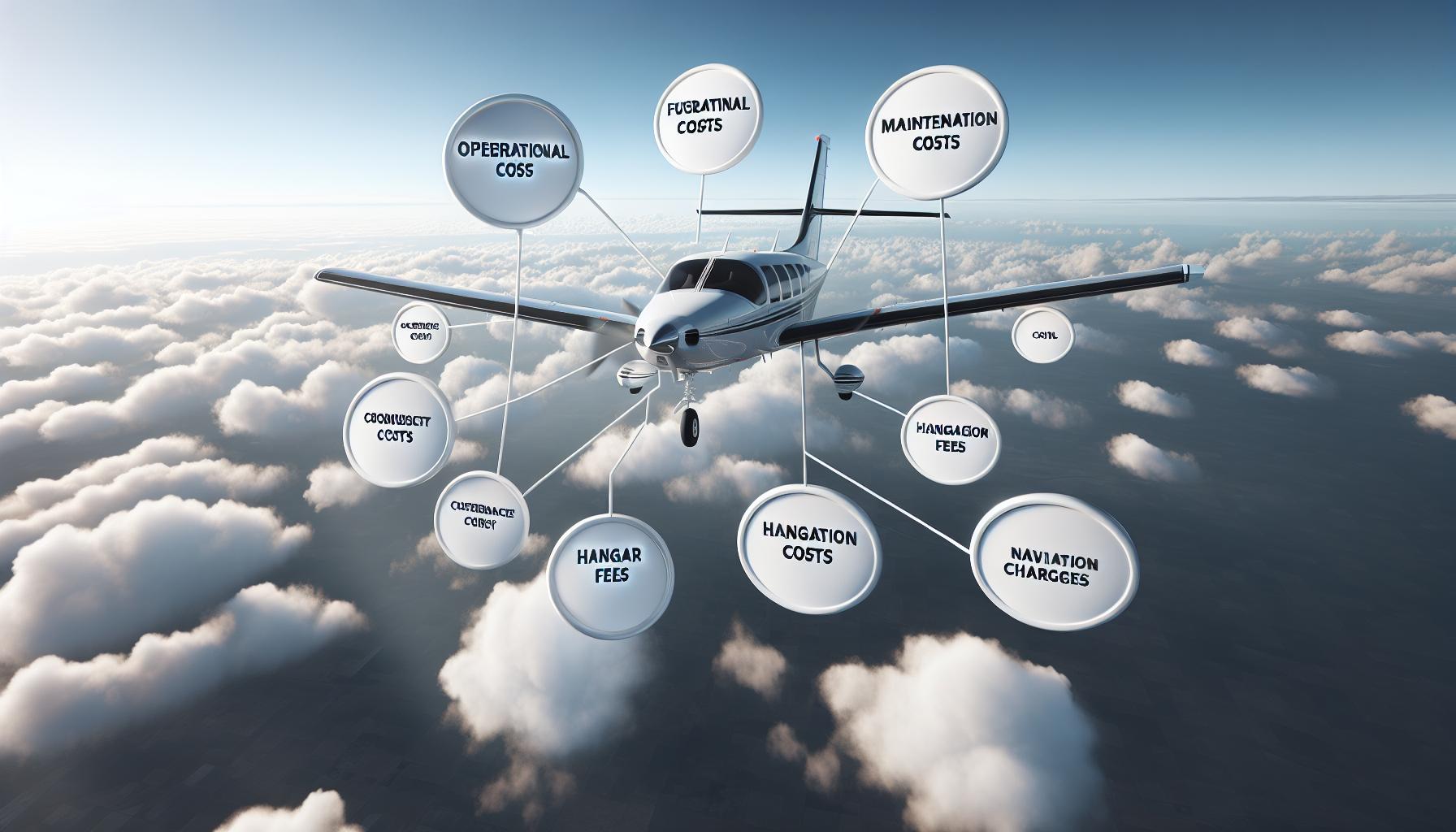
Ever wondered what it costs to fly in style? I’m talking about soaring the skies in your own Cessna jet. Having worked in the private jet industry, I’ve got the inside scoop on the hourly costs that come with these sleek birds.
Stick with me, and I’ll break down the numbers in a way that’s easy to digest. Whether you’re a flying enthusiast or simply curious, you’ll find that I’ve done my homework to bring you the most accurate figures. Let’s dive into the world of luxury aviation and find out what it really costs to operate a Cessna jet per hour.
The Cost of Owning a Cessna Jet
When you’re looking into the ownership of a Cessna jet, it’s crucial to understand the range of costs that go beyond the sticker price. As someone who’s navigated the private jet industry, I’ve got insights on the various expenses you’ll encounter.
Initial purchase price is the most obvious expenditure. Depending on the model and age of the aircraft, this can range significantly. For instance, a brand new Cessna Citation CJ3+ might set you back anywhere from $8 to $9 million. On the flip side, pre-owned models could cost considerably less.
But the purchase is just the beginning. There are operational costs to consider, which include fuel, maintenance, hangar fees, and insurance. These expenses can really add up. Fuel consumption, for instance, might be roughly 200 gallons per hour, and with aviation fuel prices often fluctuating, it’s a recurring cost that needs constant monitoring.
Maintenance is another key factor. Regular inspections and upkeep are not just necessary for safety; they’re also required by aviation law.
| Expense Type | Estimated Cost |
|---|---|
| Insurance | $10,000+/year |
| Maintenance | $500+/hour |
| Hangar Fees | $1,200+/month |
| Crew Salaries | Varies |
Crew expenses hinge on whether you employ pilots and crew full-time or on an ad hoc basis. If you’ve got a full-time crew, you’re looking at salaries, benefits, and training costs.
Don’t forget about depreciation. Like any vehicle, a jet’s value decreases over time, which can impact your financial planning.
Lastly, there are the costs associated with upgrading avionics and interiors to keep your jet modern and compliant with ever-evolving regulations. These aren’t required every year but will come around during the life of your jet.
All told, the cost of owning a Cessna jet is a mix of fixed and variable expenses, requiring careful budgeting and financial foresight. Understanding these intricacies is key for anyone considering private jet ownership.
Factors Affecting Hourly Costs

When calculating the hourly cost of operating a Cessna jet, several factors play a critical role. It’s not just about fuel burn and maintenance; a range of variables can influence the total per hour expense.
Fuel Costs: Arguably the most variable expense, fuel costs can fluctuate wildly based on market prices. For a more accurate estimate, I keep a close eye on current fuel rates and factor in the flight profile of my jet, which includes altitude, route, and speed.
Maintenance and Inspections: Regular maintenance isn’t a choice; it’s a requirement for both safety and compliance. On top of that, there are mandatory inspections known as Airworthiness Directives (ADs) and others depending on hours flown, which can add to the hourly costs.
Crew Expenses: If you’ve opted for a full-time pilot or a crew, their salaries also come into play. Remember that this includes their training, benefits, and other associated labor costs.
Hangar Fees: Storing your jet in a hangar protects it from the elements, but it also incurs costs. These fees vary depending on the airport and region.
Insurance Premiums: Insurance is non-negotiable for jet owners. It protects against potential risks and liabilities but also adds to your hourly running costs.
Here’s a ballpark range of operating costs for a typical Cessna jet, but bear in mind, these figures are estimates and can vary:
| Expense Category | Estimated Cost Range |
|---|---|
| Fuel | $400 – $800/hr |
| Maintenance | $100 – $300/hr |
| Inspections | $50 – $150/hr |
| Crew | $100 – $200/hr |
| Hangar Fees | $50 – $200/hr |
| Insurance | $100 – $300/hr |
It’s crucial I account for every one of these factors to ensure I’m not blindsided by any hidden expenses. By understanding what goes into the hourly costs, I’m better equipped to manage the financial commitments of owning and operating a Cessna jet.
Fixed Costs vs. Variable Costs

When you’re trying to wrap your head around Cessna jet ownership expenses, it’s crucial to differentiate between fixed costs and variable costs. Fixed costs remain constant, no matter how many hours you spend in the air. These are the expenses you’ll pay whether your jet is parked in the hangar or cruising at 30,000 feet. On the other hand, variable costs fluctuate based on your flight activity.
Let’s break down the fixed costs first. These typically include:
- Insurance premiums
- Hangar fees
- Annual inspections
- Crew salaries (if you employ full-time staff)
Insurance can be a tricky one—it’s mandatory and can be quite the expense. But my advice is to shop around and find a policy that meshes with both your budget and your flying habits. As for hangar fees, securing a good parking spot for your Cessna isn’t just a one-time thing. Monthly or annual fees can pile up, but trust me, they’re worth every penny in protecting your investment.
Annual inspections are non-negotiable. Safety first, right? And while your plane is sitting pretty, your crew—if you have one on standby—will still need their paychecks.
Switching gears to variable costs, these are directly tied to flight time. This list usually covers:
- Fuel
- Maintenance per hour of operation
- Catering and in-flight supplies
Fuel consumption can be the most prominent cost, and it’s mercilessly tethered to market prices. Plus, the more hours you clock, the more frequent your maintenance checks become. Keep a close eye on these; staying on top of wear and tear is non-negotiable for both safety and cost-efficiency. Lastly, if you enjoy the finer things in life like on-board dining, remember that caviar and champagne will bump up your per-hour costs swiftly.
Breaking down costs into fixed and variable helps me strategize on how to efficiently manage and allocate my funds. Understanding these distinctions is key to mastering the art of Cessna jet financials—and ensuring the freedom of the skies doesn’t cost the earth.
Maintenance and Upkeep Costs

Maintaining a Cessna jet isn’t just about the upfront costs. There’s a lot to consider when it comes to keeping it in tip-top shape. Maintenance and upkeep are where savvy owners really need to focus to ensure their aircraft remains airworthy and efficient. Trust me, regular checks and repairs are essential to prevent any costly surprises down the line.
Scheduled Maintenance is one factor that can’t be ignored. These are the routine checks dictated by the aircraft’s usage and time intervals. Think of it as a regular health check-up for your jet. The costs here can vary, but what’s crucial is not to skip these. Remember, staying ahead of wear and tear is always cheaper than dealing with a full-blown mechanical failure.
On top of that, there are Unscheduled Repairs which, as the name suggests, pop up uninvited. They’re the unpredictable issues that can spring up at any time. Even with the best care, something can always go wrong, and these repairs can be as minor as a loose seatbelt or as major as an engine overhaul.
Here’s a breakdown of potential maintenance costs that you might encounter:
| Maintenance Category | Estimated Cost Range |
|---|---|
| Scheduled Maintenance | $500 – $4,000+ per hour |
| Unscheduled Repairs | Varied (case-by-case basis) |
My top tip for managing maintenance costs? Set aside a maintenance fund and regularly contribute to it. This way, when these costs inevitably arise, you’ve got the funds ready to cover them without stress.
Moreover, don’t forget to factor in Aircraft Updates. Avionics and systems onboard your Cessna will need updates to stay current with technology and regulations. Sometimes, these updates can be simple software upgrades, other times they might require new hardware.
Safety’s always the number one priority, so keeping your jet’s maintenance and upgrades in check is non-negotiable. By acknowledging the importance of these upkeep costs and planning for them, you’ll not only safeguard your investment but also enjoy peace of mind in the skies.
Fuel Costs

When discussing the hourly cost of flying a Cessna jet, fuel expenses cannot be overlooked. They’re a significant chunk of the operational costs. To give you a better idea, I’ve dug into the numbers. Fuel consumption varies by model, but let’s focus on the Cessna Citation XLS, a popular choice among private jets.
This model burns approximately 200 gallons of jet fuel per hour. Now, considering today’s fuel prices, that equates to a considerable hourly expense. The exact figure can fluctuate with the volatile nature of fuel markets. I’ll break it down in a snapshot:
| Fuel Consumption (gallons/hr) | Fuel Cost (per Gallon) | Total Fuel Cost Per Hour |
|---|---|---|
| 200 | $5.00 | $1,000.00 |
These costs can rise or fall based on where you’re refueling since prices differ from one location to another. Fuel is generally cheaper at larger airports due to higher competition.
Another factor that impacts fuel expenses is your flight habits. Longer trips at cruising altitude can be more fuel-efficient, reducing your hourly fuel cost. Conversely, shorter flights with more take-offs and landings can drive up consumption.
As you can see, efficient flight planning is crucial to manage these costs. By optimizing your travel plans, you can achieve a balance between speed and economy. And don’t forget, fuel isn’t the only variable cost to consider. Tack on maintenance, storage, and crew salaries, and you get a comprehensive picture of what your Cessna jet might cost you per hour in the skies.
Staying informed on the latest fuel prices and being strategic with your flight scheduling are just some of the ways to ensure you’re not spending more than necessary. Keep a keen eye on the habits that can help keep your jet’s thirst for fuel at a manageable level.
Insurance and Licensing Costs

When flying high isn’t just a metaphor, insurance becomes your safety net. I’ve learned that for a Cessna jet owner, insurance premiums can dent your budget almost as much as fuel costs. They’re based on factors like your experience, the aircraft’s age, and how often you fly. For a ballpark figure, I’ve seen annual insurance expenses for a Cessna jet range from $10,000 to $20,000, depending on the coverage level.
Then there’s licensing. Keeping your certification up to date is not just about legality; it’s a commitment to safety and professionalism. The costs here can vary widely. From my research, the initial certification process for a Cessna jet could set you back a few thousand dollars. However, remember that this is a recurring cost with periodic check rides and medical exams required to maintain your license.
To make sense of these numbers:
| Insurance and Licensing Aspect | Potential Cost |
|---|---|
| Insurance Premium | $10,000 – $20,000 annually |
| Licensing | Varies (initial certification and recurring expenses) |
It’s not just the upfront payments either. You’ve got to stay sharp, and that means investing in continuous training. Whether it’s for transitioning between aircraft models or keeping your skills polished, ongoing education is essential in the aviation world. Sure, these training programs add to your operating expenses, but I can’t stress enough how crucial they are for your safety and that of your passengers.
One last thing to keep in mind is the aircraft’s value. Just as with a car, the more valuable the jet, the heftier your insurance premium. So I always recommend doing extensive research or chatting with an insurance broker to find the perfect balance for your needs. Remember, skimping on insurance could cost you more in the long run, and when it comes to flying, I’m not just talking about money.
Comparing Cessna Jet Models

When diving into the specifics of Cessna jet operating costs, it’s crucial to recognize that expenses can vary significantly between models. Cessna’s lineup features jets like the Citation Mustang, the Citation CJ3+, and the luxurious Citation Latitude, each offering distinctive capabilities and associated costs.
Let’s take the entry-level Citation Mustang as a starting point. It’s known for its affordability and is a favorite among private owners and charter companies. Its operating cost per hour hovers around $1,150, accounting for fuel, maintenance, and other variable costs.
Moving up to the mid-sized Citation CJ3+, you’ll notice an increase in both performance and cost. This model can set you back about $1,750 per hour. It offers a larger cabin, longer range, and higher speeds, which justify the increased operational costs.
On the high end, there’s the Citation Latitude. It combines a spacious cabin with intercontinental range, making it a popular choice for business travel. Operating this sophisticated jet can cost in the ballpark of $2,900 per hour.
While these figures provide a snapshot, actual costs might fluctuate due to market conditions, usage patterns, and maintenance schedules. Here are some average hourly cost estimates for a clearer comparison:
| Cessna Jet Model | Average Cost Per Hour (USD) |
|---|---|
| Citation Mustang | $1,150 |
| Citation CJ3+ | $1,750 |
| Citation Latitude | $2,900 |
Fuel efficiency is another key factor impacting hourly costs. For instance, the Mustang is more fuel-efficient than its larger counterparts, leading to potential savings on longer trips.
Of course, these operational costs represent just one part of the overall financial commitment. Insurance, licensing, and other ownership expenses also play critical roles in the total cost of owning a Cessna jet. Smart owners often mitigate these recurring costs by opting for shared ownership models, which can greatly reduce the financial burden while still providing the perks of jet ownership.
Remember, when it comes to owning a Cessna jet, the price tag of the aircraft itself is just the beginning. It’s the ongoing costs, such as hourly operating expenses, that shape the true cost of jet ownership. Keeping a keen eye on these will ensure you’re prepared for the financial journey that comes with your Cessna.
Conclusion
Owning a Cessna jet is a luxury that comes with its own set of financial considerations. The hourly operating costs of these jets clearly reflect the level of investment required. Whether you’re drawn to the efficiency of the Citation Mustang or the advanced capabilities of the Citation Latitude, it’s evident that each model caters to different needs and budgets. Remember that fuel efficiency plays a crucial role in managing expenses and shared ownership could be a smart way to enjoy the benefits of a private jet without bearing the full brunt of the costs. Ultimately, the joy of jet ownership must be balanced with a clear understanding of the ongoing financial commitment it entails.
Frequently Asked Questions
What is the hourly operating cost of a Cessna Citation Mustang?
The Cessna Citation Mustang has an approximate operating cost of $1,150 per hour.
How much does it cost to operate a Cessna Citation CJ3+ per hour?
Operating a Cessna Citation CJ3+ costs around $1,750 per hour.
What is the hourly operating cost for a Cessna Citation Latitude?
The operating cost per hour for a Cessna Citation Latitude is about $2,900.
Are there differences in fuel efficiency between Cessna jet models?
Yes, fuel efficiency varies between models, with the Citation Mustang being more fuel-efficient compared to larger Cessna jets.
Do operational costs include ownership expenses like insurance and licensing?
No, operational costs typically cover direct expenses like fuel and maintenance, not ownership expenses such as insurance and licensing.
Is shared ownership a viable option to reduce the costs of owning a Cessna jet?
Yes, shared ownership models can help reduce the recurring costs of owning a Cessna jet while still providing the benefits of jet ownership.
